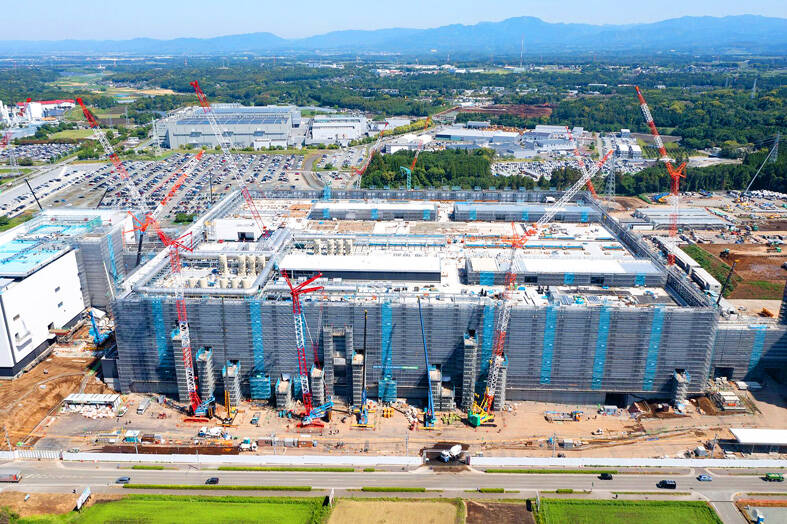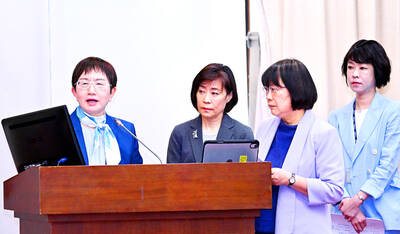The Japanese government is to pay for a significant part of a second Taiwan Semiconductor Manufacturing Co (TSMC, 台積電) factory in southern Kumamoto Prefecture, leaders of the ruling party’s lawmaker coalition on chips said.
Giving no support would be out of the question after the government pledged to shoulder half the cost of the first Kumamoto plant, said Akira Amari and Yoshihiro Seki, chairman and secretary-general of the Liberal Democratic Party’s group on semiconductors.
Amari said about one-third of the cost is the norm for these types of projects, and the amount of support for the first was unusually large.

Photo: Bloomberg
The subsidies would be part of Japan’s efforts to revive its domestic chipmaking industry, a sector that is viewed as crucial for growth and economic security, Amari said.
“This is a national strategy,” Amari said in an interview in Tokyo on Wednesday. “We are facing the kind of choice that will set our course over the next decades. Are we going to be a receiver of chips or a provider? Which is better? We have no choice but to take on this challenge, regardless of the outcome.”
Whether or not the government would also pay for half of the second TSMC plant would depend on what type of chips are to be made there and how much of a wider economic impact it can generate in the region, Seki said.
For example, the government would be more supportive if TSMC plans to train many Japanese engineers through its own more technically advanced workers, he said.
“The plant will certainly boost the economy and we will back it,” Seki said in a separate interview on Wednesday in Tokyo. “Around the globe, governments are pouring in support. If Japan alone does not do anything, we will not be able to attract top chip companies from the rest of the world.”
The lawmakers also said they would like to see at least ¥1 trillion (US$7 billion) of chip-related support in an extra budget this year, which would likely be compiled toward the end of the calendar year.
“Investments in the trillions of yen are the global standard when it comes to chips,” Amari said. “We will secure a substantial budget amount.”
While the second TSMC plant has not officially been announced by the company, aid for it could be part of that budget, Seki said.
Money could also go to legacy and power semiconductor production in need of support.
TSMC chairman Mark Liu (劉德音) in June said that the company is in discussions with Japan over subsidies for a second facility, which might be located alongside its current plant in Kumamoto.
Japan plans to invest about ¥10 trillion in semiconductors over the span of a decade, Japanese Prime Minister Fumio Kishida said last year.
So far, about ¥1.76 trillion has been set aside for the nation’s chip and digital strategy that was created in 2021 and revised this year, the Japanese Ministry of Economy, Trade and Industry said.
Of that total, ¥1.2 trillion is for semiconductors, ¥500 billion for storage batteries and ¥60 billion for software-related initiatives.
Japan is aiming to triple the sales of domestically produced semiconductors to more than ¥15 trillion by 2030.
Key aid pledged so far includes ¥476 billion for the first TSMC plant, set to begin production late next year, and ¥330 billion for Japan’s homegrown semiconductor venture Rapidus Corp in northern Hokkaido.
The TSMC case has justification in that it brings the world’s leading chipmaker to Japan, but the risk is higher for Rapidus, Seki said.
The latter is a brand new start-up that aims to mass produce the most advanced form of chips, uncharted territory for Japan, and the government is planning on providing further support.
“I recognize this is a tough project,” Seki said of Rapidus. “We won’t be able to succeed unless we think that there’s no choice but to succeed.”

‘SWASTICAR’: Tesla CEO Elon Musk’s close association with Donald Trump has prompted opponents to brand him a ‘Nazi’ and resulted in a dramatic drop in sales Demonstrators descended on Tesla Inc dealerships across the US, and in Europe and Canada on Saturday to protest company chief Elon Musk, who has amassed extraordinary power as a top adviser to US President Donald Trump. Waving signs with messages such as “Musk is stealing our money” and “Reclaim our country,” the protests largely took place peacefully following fiery episodes of vandalism on Tesla vehicles, dealerships and other facilities in recent weeks that US officials have denounced as terrorism. Hundreds rallied on Saturday outside the Tesla dealership in Manhattan. Some blasted Musk, the world’s richest man, while others demanded the shuttering of his

ADVERSARIES: The new list includes 11 entities in China and one in Taiwan, which is a local branch of Chinese cloud computing firm Inspur Group The US added dozens of entities to a trade blacklist on Tuesday, the US Department of Commerce said, in part to disrupt Beijing’s artificial intelligence (AI) and advanced computing capabilities. The action affects 80 entities from countries including China, the United Arab Emirates and Iran, with the commerce department citing their “activities contrary to US national security and foreign policy.” Those added to the “entity list” are restricted from obtaining US items and technologies without government authorization. “We will not allow adversaries to exploit American technology to bolster their own militaries and threaten American lives,” US Secretary of Commerce Howard Lutnick said. The entities

Minister of Finance Chuang Tsui-yun (莊翠雲) yesterday told lawmakers that she “would not speculate,” but a “response plan” has been prepared in case Taiwan is targeted by US President Donald Trump’s reciprocal tariffs, which are to be announced on Wednesday next week. The Trump administration, including US Secretary of the Treasury Scott Bessent, has said that much of the proposed reciprocal tariffs would focus on the 15 countries that have the highest trade surpluses with the US. Bessent has referred to those countries as the “dirty 15,” but has not named them. Last year, Taiwan’s US$73.9 billion trade surplus with the US

Prices of gasoline and diesel products at domestic gas stations are to fall NT$0.2 and NT$0.1 per liter respectively this week, even though international crude oil prices rose last week, CPC Corp, Taiwan (台灣中油) and Formosa Petrochemical Corp (台塑石化) said yesterday. International crude oil prices continued rising last week, as the US Energy Information Administration reported a larger-than-expected drop in US commercial crude oil inventories, CPC said in a statement. Based on the company’s floating oil price formula, the cost of crude oil rose 2.38 percent last week from a week earlier, it said. News that US President Donald Trump plans a “secondary